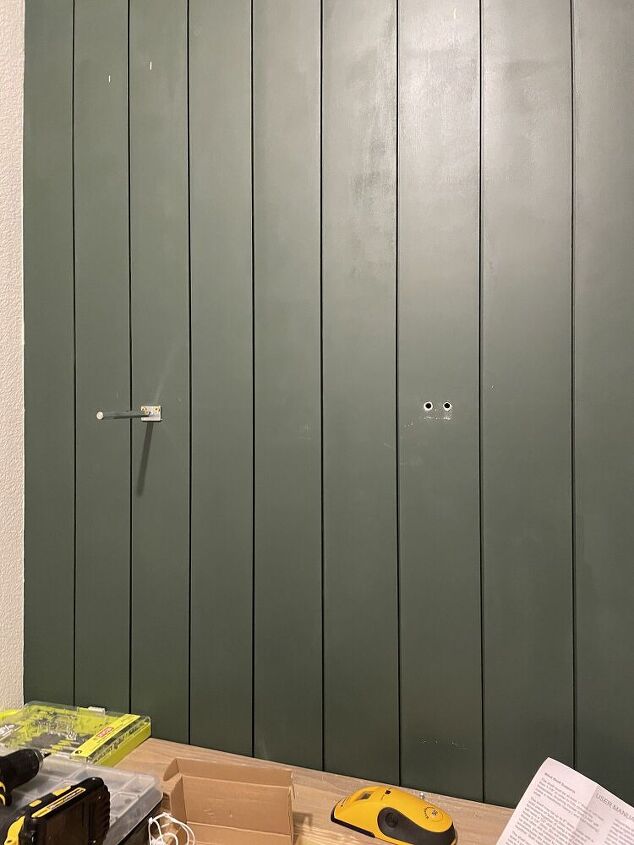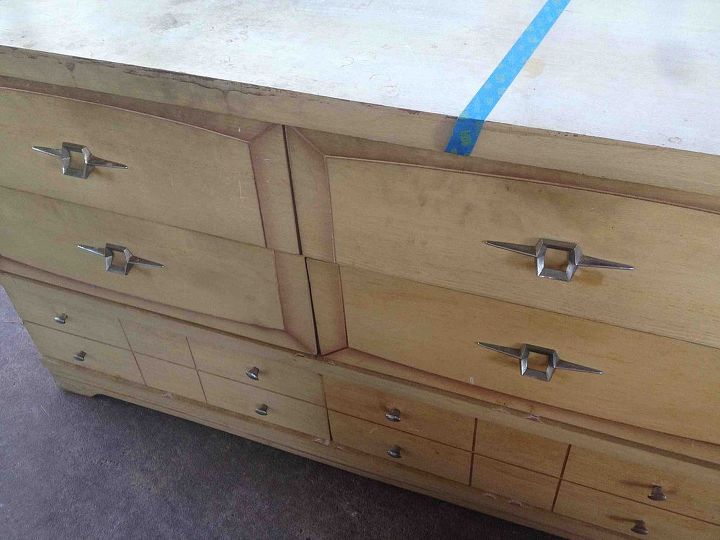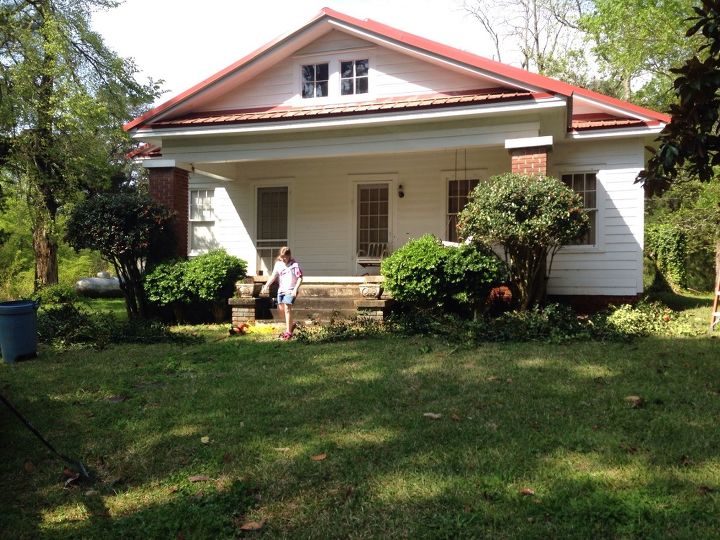How to hang floating shelves on shiplap?

I put up shiplap in a small nook area. I attached the shiplap to furring strips because I did not want to damage the walls. The problem I am having now is that the holes I drilled are too deep and the screws I had for the shelf anchor I am using are not long enough. I also don't know if I got a stud or not because of the depth of the shiplap against the wall. What can I use to make sure I can get the screw into the wall? Do I need a longer screw? I will also prob need anchors to fit to secure the shelves.
The furring strips are .75"H x 1.5"W x 8ft L
The shiplap is .5625"H x 5.25" depth x 8 ft wide
The mounting screws I purchased are these
https://www.amazon.com/gp/product/B0774MT62N/ref=ppx_yo_dt_b_search_asin_title?ie=UTF8&psc=1
Related Discussions
Vinyl plank flooring vs pergo (laminate)
I currently have stinky dirty carpeting in my living room and I want to replace it with a durable flooring that can stand up to dogs and kids.
How to remove popcorn ceiling that has been painted?
Does having a paint over a popcorn ceiling change how I'd remove the popcorn ceiling?
How to apply peel and stick wallpaper?
I want to spruce up my walls with peel-and-stick wallpaper. Has anyone used this before and can advise me as to how to apply it properly?
How to stain wood floor?
I've heard staining is a good technique for updating floors. So how do I stain my wood floor?
Curb side find! What would you do?
I found this in the curb this morning on my way to work. Needless to say I'm late :) does anyone know anything about this piece? What would you do with it? Paint? Res... See more
Help please! What color for the front door?
We're remodeling this 1930's house. We have a new red metal roof & plan to keep the white siding. What would you suggest as a front door color? I love bright, bold co... See more




Those brackets are made to be attactched to a solid wall. You do not have that. You will need longer screws. I suggest at least 3" screws. Anchors won't work unless you can get them into the wall past the shiplap.
In your situation with the shiplap on firing strips and a 3/4" gap between the shiplap and wall. These floating shelves would work the best.
https://www.hometalk.com/diy/build/shelves/easy-floating-shelf-44325228
https://www.hometalk.com/diy/build/shelves/diy-floating-shelf-build-and-install-37031284
https://www.hometalk.com/diy/build/shelves/not-another-floating-shelf-video-44309787
Easy Floating Shelf
DIY Floating Shelf Build and Install
Not Another Floating Shelf Video
Thanks! What if I make pocket holes instead and use a really long screw? I already have my wood I am using for the shelf sanded and stained. Don't really want to start all over!
You can use a stud finder (they aren't very expensive) to locate where the studs are in the wall behind the shiplap. Then use screws that are long enough to penetrate through. I'm guessing the shiplap you installed isn't very thick. If it is actual shiplap or thick wood panels, you would only need to attach to that wood to hang your shelves.
Hello, here are a few videos that may help you out,
https://www.youtube.com/watch?v=Do6WSonL6RE
https://www.youtube.com/watch?v=rgQyZX1sg38
If the depth of the shiplap is 5.25", then you'll need screws longer than that to reach the wall.
Make sure you use anchors for wood
'Just a reminder to make sure you use a level wide enough to to mark all the drill holes carefully before boring into the wall. It is important that both brackets are level with each other before the shelf goes on.
Hi! Good advice from everyone! A stud finder, wall anchors, and longer screws will make all the difference. Use wood filler to repair the holes. You can often find a close match. You should be able to hide the damaged areas with the shelf installation. Good luck!
You could try toggle bolts...
Have you had any luck yet? My solution is a little more extreme. If you have the shelf, have someone hold it exactly where you want it and trace the outline. Measure in 1.5 inches from all sides and connect the points so you have the shape of the shelf, but smaller dimensions. Now cut out that section of ship lap. Do some exploratory drilling to find your studs if your stud finder is not working. Drilling through the drywall into space will feel different from hitting a stud. if you hit a stud you will feel some resistance and your drill will pull out some wood along with drywall material and possible some insulation. You can always add back some 3/4 inch stock to get you flush with the ship lap to attach your brackets. You will be covering the area with the shelf so you will never see the cut out section. You might even be able to reattach it.
Floating Shelves Shiplap Wall
https://www.houzz.com/discussions/5336930/floating-shelves-shiplap-wall
Here are pics for reference of what is attached to the wall!!
Remember that the studs are most likely 16 inches on center. The corner is framed something like the picture below. From the middle of one stud to the next is 16 inches. Try measuring and see if your stud finder shows the same location as your measurement. Between the two methods, you can be reasonably sure you are hitting a stud. The question will be are both screws of the bracket hitting a stud. Another method to try is to drill a pilot hole to a very specific depth; thickness of ship lap+thickness of furring+ thickness of drywall+ 1/16th. Put tape around your drill bit to mark the depth. Drill the pilot hole. Use something thinner than the drill bit to probe the hole like a bamboo skewer. Mark the same depth on the skewer. Do you hit something at that depth? If not, you missed the stud and went through the drywall into space. If the skewer bottoms out, you hit a stud. Since your test holes will be covered by the shelf, you don't have to worry about making a few of them to find the studs.
I have a few questions about your measurements and what you mentioned. First, what is the width of the wall you are putting the shelf on? From the numbers you gave, it seems to be about 44 inches. Because your measurements are odd for stud spacing and because you measured the studs being 3 inches wide, I am wondering if your stud finder needs to be calibrated or if the deep scan is just not working well due to the different materials and thicknesses you have going on. While stud spacing is usually 16 inches on center, that does not mean that section of wall is different. The framer may have taken the width of the wall and divided it equally for stud spacing that is not 16 inches on center. You say the stud is 3 inches wide, but the side of the stud facing you that you are trying to screw into is only 1.5 inches wide. That is the way walls are framed and your bracket is 1.5 inches wide meant to match that dimension of the stud. Also, what is on the other side of that wall? Do you live in a house, apartment or condo? As to the 5.5 inch depth, you have the 1.25 inch thickness of the shiplap and furring, then you have 3/4 or 5/8 of drywall thickness, then you have 3 inches of stud depth before you hit the back of the wall on the other side of the stud. Could you have drilled into or even through the drywall on the other side of the wall you are hanging the shelf on? Lastly, what size hole did you drill or what was the drill bit size? One last thing comes to mind and that is if there are any pipes in that wall.
Here is the pic of the area.
Yay for pictures! Your job just got easier, maybe. The magnets may not work because they will not go deep enough to pick up the screws in the drywall, but give them a try. And, we were all newbies once. I have been doing DIY work for 35 years and screw stuff up all the time. Did you install the bottom cabinet? It does not look like it was custom made for that space. If installed by the builder, I am assuming the bottom cabinet is screwed to the wall and the screws are hitting studs if it was installed correctly. Look inside the cabinet for places you see screws going through the back. Measure the distance from the left edge of the cabinet and account for the gap between the wall and the cabinet and the thickness of the cabinet, probably 3/4 of an inch. Use those measurements up top from the left wall in to where you want to hang the shelf. That's where the studs are. There is no guarantee there is a screw in each stud inside the cabinet, and we still may not be able to tell how many studs are in that space and how they are spaced apart, but you may have a better idea if there are screws inside the cabinet. Another thing you can try is to look inside your coat closet. If there is trim along the bottom, it should be nailed into studs. Same for any shelves inside. If you don't mind making a small hole in your closet wall, Use the magnets in the closet to find the studs. Using a longer drill bit (like 6 inches), drill a hole next to the stud you find in the closet going all the way through the shiplap on the other side to show you where that stud is. Other than that, it's a time consuming hunt by drilling test pilot holes. Use a thin drill bit. You are going in about 1 7/8ths to 2 inches before hitting a stud or popping through the drywall into empty space. You just have to do it by feel. As William suggested, you want at least one of the screws to be in a stud. It's probably okay if the brackets are not evenly spaced apart since you won't see them. You may not have studs where you want the brackets to go, so now you are back to using wall anchors like molly bolts. I think if you add a third bracket at least one of them has to hit a stud.
You have trim along the bottom behind the cabinet. It should be nailed to studs. The nails might have been counter sunk and filled, bit if you look close enough or pry the trim away from the wall, you will find the studs. It is also thinner there with just the drywall over the studs so your stud finder or magnets will work better. I would not hesitate to take the trim off to find the studs. I also would not hesitate to drill new holes for the brackets if it means hitting a stud and if your shelf will cover the old holes. I'm not sure how you intend to use pocket hole screws in a way that would be easier.